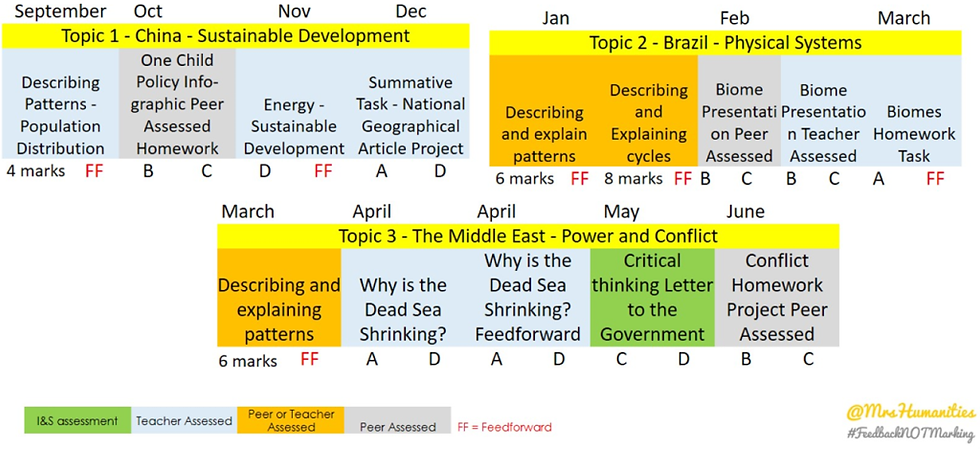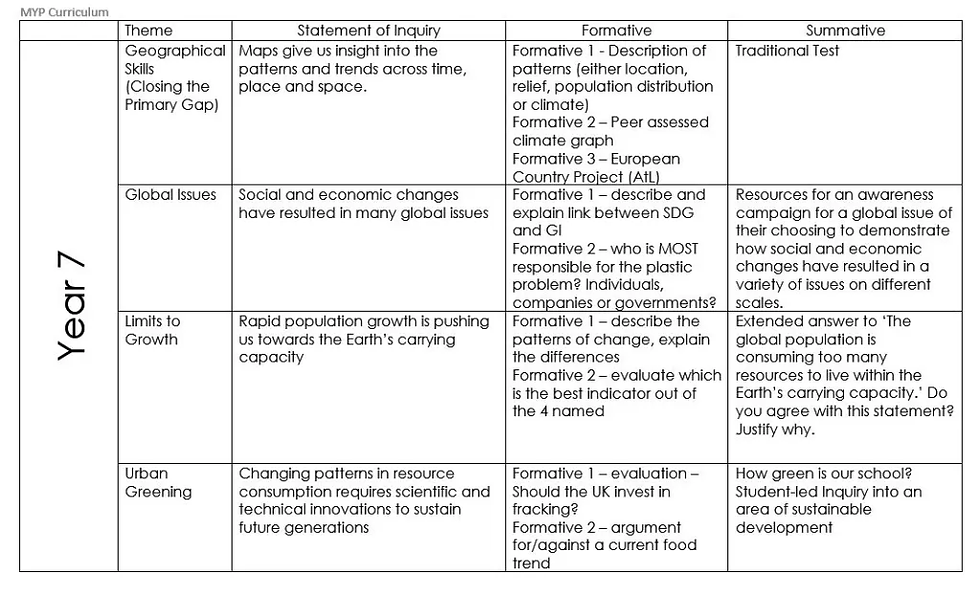Creating a Coherent Curriculum: Geography
- Victoria Hewett
- Oct 5, 2019
- 5 min read
Updated: Jun 19, 2023

Creating a coherent curriculum is no easy feat. I know because I once did it from scratch single-handily for Humanities!
Thankfully, I’m no longer in that position and have a fantastic team around me to develop ours. In the 3 years I’ve been at this school, I’ve been making slow changes to our MYP (KS3) Geography curriculum.
What I inherited was okay, but it desperately needed a revamp and some coherency. In that time there have been two new IB specs one for Geography and one for ESS, along with the new 9-1 GCSE spec, MYP unfortunately had to take a back seat. However this year, it’s turning into what I’ve envisaged for the past 3 years; a coherent curriculum, and I’m excited.
I’m going to outline the steps taken but do note this has been a slow process and not all in one go. I didn’t want to change everything at once.
Step 1. Planning Backwards
The first step has actually been getting my head around the new IB and GCSE specs and considering how everything we do prior to exam years is foundation setting whether it be skills or knowledge and understanding.
I carefully unpicked the assessment criteria and content of the IB and GCSE specifications in order to work out exactly where we were going to go with our curriculum. Some questions that drove my thinking included:
What do they need to be able to do at the end of GCSE?
What do they need to be able to do at the end of IB?
What would we want them to take away from Geography if they decided not to carry it on at GCSE or IB?
How were we going to develop and enhance our students understanding and experience over the 5 or 7 years in which they study geography?
How were we going to enable them to get the most of their studies?
How could we support and facilitate them in becoming independent learners?
How could we take their learning beyond the specifications?
Useful Resources
Start at the End -A Case for Backwards Planning How to use Backwards design for effective lesson planning! Outstanding Teaching: Teaching Backwards TEACHING BACKWARDS TOPIC PLANNER
Step 2. Spiraling Curriculum
Before the next step I investigated the concept of a spiraling curriculum and from there considered with my team at the time the themes, concepts and skills we felt should be built upon from year 7 to year 13.
Our reoccurring themes were to include:
Physical geography
Population and Demographics
Culture and Society
Sustainability and the Sustainable Development Goals
Global Interactions
Geographical Skills
Since I didn’t want to change everything at once, I decided it would be beneficial to make as much use of what we already had in place and instead refocus and develop it. So with that in mind we decided upon the overall topics of study. They were to be as follows:

Then we decided on some regional or national areas of study to locationally focus the themes.
Initially we decided on the following:

I wrote about my initial ideas here towards the end of year 1.
However the following year when we actually started to implement a spiraling curriculum, we decided to change some of our initial plans. We removed the topic on tourism and replaced it with a topic from GCSE – The Challenge of Resource Management. In doing so we made our Weather and Climate topic the unit in which we assessed all 4 MYP I&S criterion to be able give students an overall grade for their MYP experience when we then wrote their reports in the Summer. We created a unit which provided lots of insight into and knowledge of the topic and then allowed students to follow the avenue of inquiry they found of most interest.
Useful Resources
Research into Practice: The Spiral Curriculum The Evidence People: Jerome Bruner’s constructivist model and the spiral curriculum for teaching and learning
Step 3. Planning Assessments
Next step was looking at the formative and summative assessments we already had and considering how they fitted in. Initially there had been too many assessed pieces of work in the units; I wanted to strip that back and look at how they actually fed into one another across the unit, across the year and across the key stage.
To do this I looked at the content, the skills and summative assessment for the unit as well as how we were going to build upon that from the units came before. It required big picture thinking.
What I came up with was a formative and summative assessment similar to that outlined below:

This example is for year 8. It identifies the assessed work for the topic, both formative and summative and who should be assessing and feedbacking on it. Tasks that required students to be provided with the opportunity to feedforward on the piece of work were also identified.
In the first topic, the feedback for the first two pieces of feedforward work came from the teacher so as to set up expectations and demonstrate effective feedback that allowed for action. From there the teacher could develop effective peer assessment routines that allowed students to feedback to one another before acting on that feedback prior to teacher assessment.
At the same time, each assessed piece of work assessed different MYP criterion. We looked carefully at the spread across the year to ensure all criterion could be built upon as students progressed.
Step 4. Planning Feedback
Final stage in all of this has been planning feedback, although this had been considered throughout it was only at the end that I could make it all explicit. I set about creating success criteria and feedback sheets for formative and summative assessed MYP work.
The feedback sheets for formative assessed work now look something like this:


Whilst summative feedback looks something like this:

The criterion changes dependent on that which is applicable.
An example of how I use and embed formative and sumamtive feedback in my MYP classroom can be seen here.
GCSE and IB were somewhat easier to plan for. We only assess past paper/exam style questions – these equate to assessed work every 2-3 weeks. More info here. Therefore assessment for learning, self and peer assessment and verbal feedback is vital in lessons to ensure students leave feeling confident in what they have covered and so the teacher can effectively plan future lessons based upon the feedback they receive from the above.
Useful Resources
What changes have taken place?
Many! Towards the end of the last academic year, I sought to update the MYP curriculum in which we’d developed, particularly our year 7 curriculum. Since only 2/4 of us would be here come September, we both worked together to redesign our year 7 experience to give a global insight which would lead to national/regional studies in year 8 and 9.
Whilst this year we are exploring the embedding the themes implicitly rather than explicitly in year 7 and whilst maintaining the explicit themes in year 8 and 9.
What does it look like completed?
To start with, we are still working on this. My team has changed this year so their input into the development of the curriculum I feel is important. My aim this year to improve on our collaborative unit planning and resource sharing to ensure consistency in experience across geography.
So this is what our MYP curriculum looks like at present.



The following is an example of a unit of inquiry from our MYP curriculum. You can see that it outlines the objectives, content and assessment.

At GCSE we follow AQA and at Key Stage 5 we follow the IB. The development of these is a whole other post.
So for now I’ll leave you with some useful reading to support the above approach to curriculum planning.
Comments